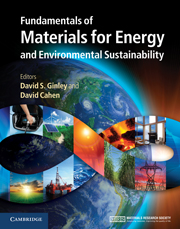Book contents
- Frontmatter
- Contents
- Contributors
- Preface
- Acknowledgments
- Part 1 Energy and the environment: the global landscape
- 1 A primer on climate change
- 2 The global energy landscape and energy security
- 3 Sustainability and energy conversions
- 4 Energy cost of materials: materials for thin-film photovoltaics as an example
- 5 Economics of materials
- 6 Global energy flows
- 7 Global materials flows
- 8 Carbon dioxide capture and sequestration
- Part 2 Nonrenewable energy sources
- Part 3 Renewable energy sources
- Part 4 Transportation
- Part 5 Energy efficiency
- Part 6 Energy storage, high-penetration renewables, and grid stabilization
- Summary
- Appendix A Thermodynamics
- Appendix B Electrochemistry
- Appendix C Units
- Index
- References
4 - Energy cost of materials: materials for thin-film photovoltaics as an example
from Part 1 - Energy and the environment: the global landscape
Published online by Cambridge University Press: 05 June 2012
- Frontmatter
- Contents
- Contributors
- Preface
- Acknowledgments
- Part 1 Energy and the environment: the global landscape
- 1 A primer on climate change
- 2 The global energy landscape and energy security
- 3 Sustainability and energy conversions
- 4 Energy cost of materials: materials for thin-film photovoltaics as an example
- 5 Economics of materials
- 6 Global energy flows
- 7 Global materials flows
- 8 Carbon dioxide capture and sequestration
- Part 2 Nonrenewable energy sources
- Part 3 Renewable energy sources
- Part 4 Transportation
- Part 5 Energy efficiency
- Part 6 Energy storage, high-penetration renewables, and grid stabilization
- Summary
- Appendix A Thermodynamics
- Appendix B Electrochemistry
- Appendix C Units
- Index
- References
Summary
Focus
Renewable forms of energy are being sought to fulfill future needs in the face of declining fossil-fuel reserves. Much attention is being paid to energy availability, the economy, and the effects that changes in the two might have on daily life. However, little emphasis has been placed on the question of how much energy must be spent to get new sources of energy into the economy in the first place. This chapter examines this question using thin-film photovoltaics as an example.
Synopsis
Prior to the 1740s, only 13 elements in what is now called the periodic table were known to exist. By the twentieth century, all 90 naturally occurring chemical elements had been discovered and put to use in the economy. Industry has found methods of extracting, refining, and using just about every material humans have found on Earth, and this process continues to evolve today as the demands of a continually growing industrial society require ever more complex materials. As much as materials make today's industries possible, they also represent a constraint – because raw materials are needed to produce desired goods and, in turn, energy is required to develop the materials as well. Nowhere is this more important than in the energy production systems that power today's world and those that will power future societies as well.
- Type
- Chapter
- Information
- Publisher: Cambridge University PressPrint publication year: 2011



